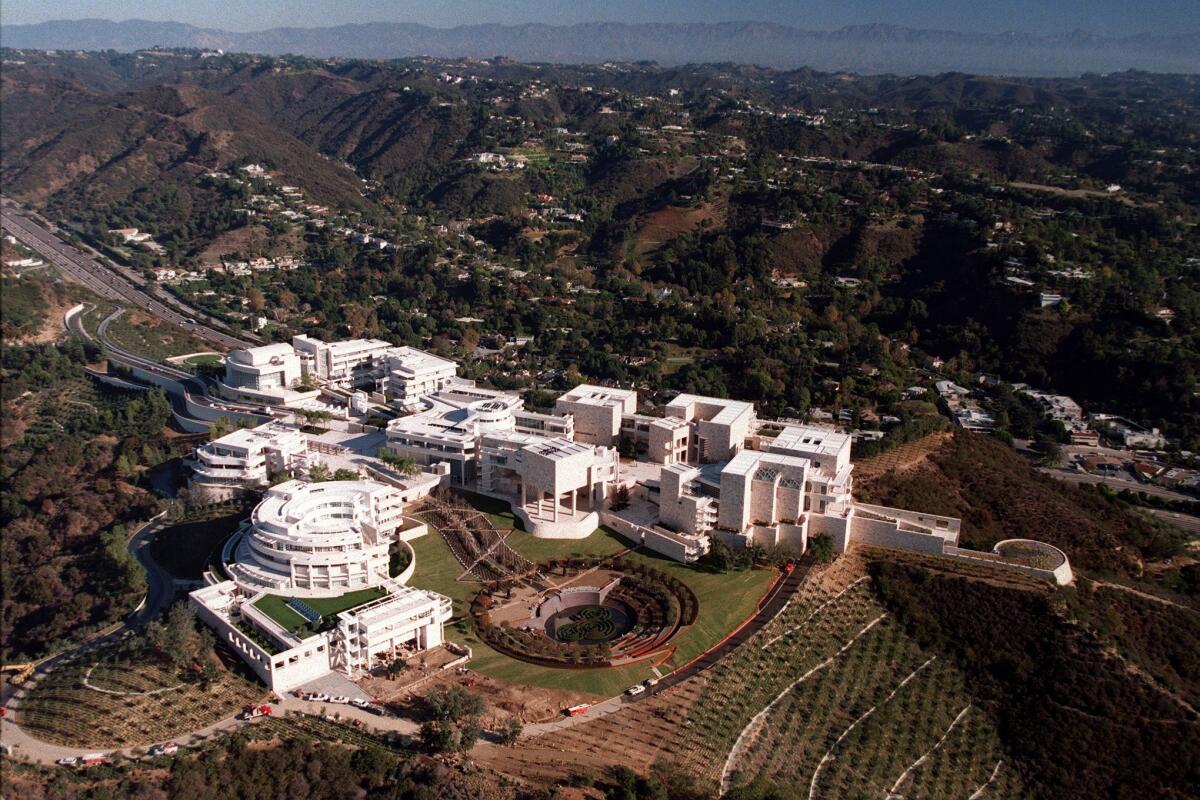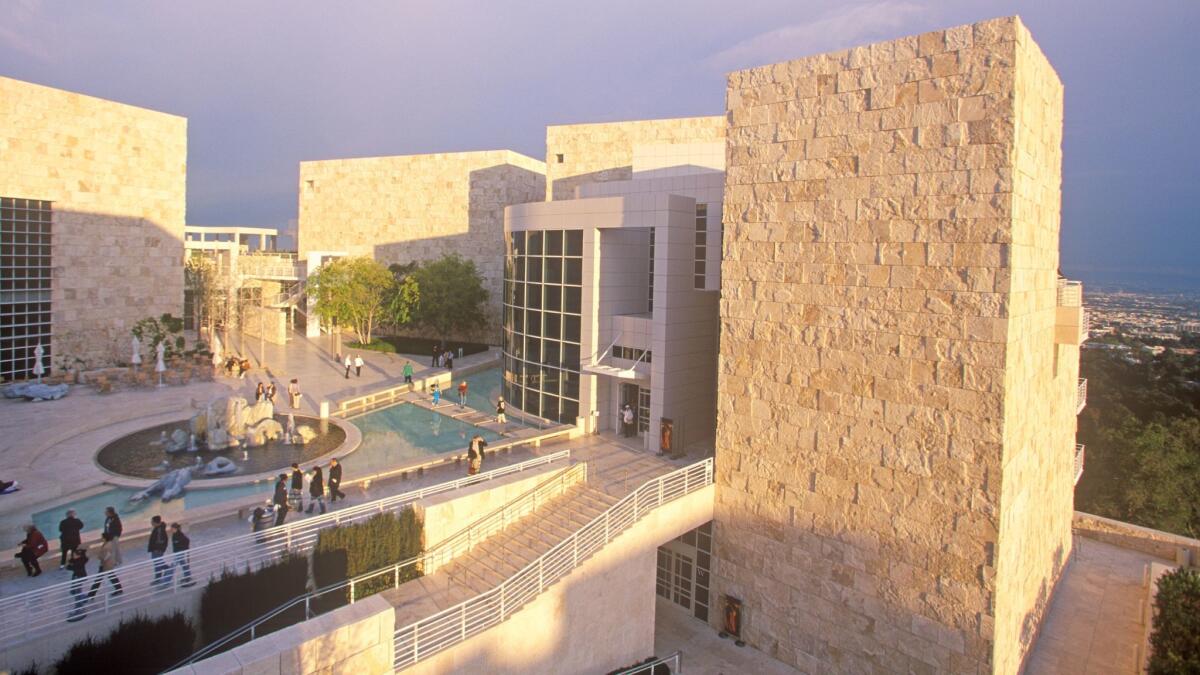Richard Meier on the Getty Center as it turns 20
- Share via
The Getty Center, that collection of hilltop buildings in travertine and white metal panels designed by the New York architects Richard Meier & Partners, opened to the public on Dec. 16, 1997. To mark the 20th anniversary of the Brentwood complex, we reached Meier, now 83, by phone to ask him about his memories of getting it built.
I was reading up on the original Getty design competition, in 1983-84, where you wound up beating out Fumihiko Maki and James Stirling to win the job. What do you remember about the competition and your approach?
I remember first receiving a letter from someone at the Getty asking if I would be interested in being interviewed as one of the people they were considering as architects for a new building. They whittled the selection down to around 30, and asked for more information. From the 30 I think they then changed the committee that was reviewing all of this — including some trustees and John Walsh, the director — and selected seven. They wanted to see buildings we were working on or had completed. I remember they went to see the High Museum in Atlanta, and other works, and came to the office in New York. From the seven they picked those three. We were asked then to write something about how we saw the project — not very long, but what was our view of what it might be. Not design, but just sort of talking about Los Angeles and climate and the site. Then from the three I was selected. That whole process took more than a year.
You had just turned 50. Did you see the Getty as a culmination of what you’d been doing or — given this really unusual site and program — as a chance to try some new things?
I saw it as an unusual project. It’s not the sort of thing that came along before — or after.
What did you make of the huge site, more than 700 acres, when you first began thinking seriously about how to build up there?
The person who had owned the property who lived actually across the freeway, he had a hobby where he had a tractor and he’d sort of move the earth around on the site. It wasn’t as if the land were in its natural form.

There is a critique now of the site as being too detached from the city.
There was always a controversy about that. There were people who felt the Getty should build in the downtown area, which would have made it more accessible by public transportation. But the Getty board wasn’t interested in that. They wanted their own place. They didn’t want to be part of downtown renewal.
The first Getty Museum — now the Getty Villa — opened in 1974. It’s easy to think of it as significantly predating the new hilltop museum, but in fact when you were chosen it was only 10 years old. Do you remember what you made of that building?
It was pastiche. It was a reconstruction of the Villa dei Papiri [a Roman villa in Herculaneum]. A very nice long fountain as you entered, but the galleries were not what you would think of as good museum spaces.
There was a sense that the budget for the Getty Center, while not unlimited, was unusually generous. Were you able to execute most of what you wanted?
Actually, I remember when it was announced that the Getty was going to build something there, they said it was going to be very expensive, something like $100 million. At that point there was no program, there was no real sense of what it would be. That number was just thrown out as an indication that the Getty was going to spend a good amount of money. All of this at the beginning occurred before the stock price of Getty Oil ballooned, leaving a good deal more money to spend.
It ended up of course being 10 times that original estimate. There are famous stories about the neighbors being involved in the design process and the question of how white the building would or wouldn’t be, given the consistent whiteness of your work up until then. What do you remember about that?
There was a committee formed by the neighborhood association and I remember meeting with them early on. And they said, “We don’t want to see it, we don’t want to hear it, we don’t want to smell it.” We had to draw different sightlines from different houses in the neighborhood to show that from their backyards they wouldn’t see any of the buildings.
What about the decision to use travertine? Were you reluctant to make that switch?
No, actually I wasn’t. The Getty was an institution that wanted a sense of permanence and a solidity to it and the choice of travertine was a way to express that, that the Getty was going to be around for a long time.

SIGN UP for the free Essential Arts & Culture newsletter »
Your relationship with Robert Irwin, the artist brought in to design part of the garden, was also famously contentious. Where does that stand? Do you talk with him at all?
No.
I know he contributed a piece of public art to the federal courthouse in San Diego, which was designed largely by your partner Michael Palladino. So that project was not something you discussed personally with Bob?
No.
During the design process at the Getty, did you have a clear sense of who your client was? There was John Walsh, the director, as well as Harold Williams, the president of the Getty Trust, and the various directors of the institutes.
Harold was the orchestra leader. He allowed Kurt Foster, who was then the head of the center for research, to be the spokesperson for that part of the project. Luis Monreal was responsible for the Conservation Institute. Each director was very much involved.
The part of that process that got the most attention was the design for some of the gallery interiors by Thierry Despont. What do you remember about all of that?
Gillian Wilson, who was head of decorative arts — she was the one who pushed for Thierry Despont to do the decorative arts galleries. He was an interior decorator and she felt the decorative arts galleries should be done by a decorator and not by an architect. [Note: Despont was also trained as an architect.] I wasn’t happy but I finally said, “OK, that’s the way it is.”
What’s your sense of how the Getty as an institution has changed over these intervening years?
Well, I think James Cuno has done a terrific job. Not just at the Getty but in terms of how the Getty interacts with other institutions and what it sponsors — things outside of itself.
I wanted to ask you about some New York museum architecture, if you don’t mind.
Sure.
What do you make of Renzo Piano’s new Whitney Museum?
Ah, well. It’s a terrific site. Somehow when you’re in the Whitney you don’t have a sense of the city around you or its relationship to the city.
Are you a fan of old Whitney, by Marcel Breuer?
Well, I worked for Breuer for years. I didn’t work on the Whitney but I never thought it was his best building.
How much have you been able to visit the Getty over the years?
I used to come back quite regularly. I lived on the site for 12 years. I was on the site every day during that period of design and construction. For a time I had a small house on the edge of the site where I lived. Everybody has their favorite spot at the Getty. I can’t tell you over the years the numbers of people I’ve met who said, “Oh, I went to the Getty and spent the whole day, and it was a wonderful experience, but I never went into the museum.”
Anything you were unhappy with when it was finished? Anything you would do differently?
If there was, I’ve forgotten about it.
Twitter: @HawthorneLAT
The biggest entertainment stories
Get our big stories about Hollywood, film, television, music, arts, culture and more right in your inbox as soon as they publish.
You may occasionally receive promotional content from the Los Angeles Times.








